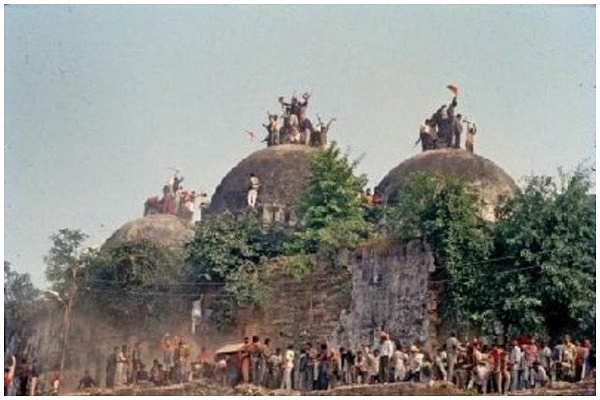
How Leftist Historians Delayed A Peaceful Settlement Of The Ayodhya Dispute For Close To Three Decades
An amicable settlement between Hindus and Muslims would have been arrived at in 1990s itself.
But some ‘eminent historians’ took it upon themselves to create animosity between the two by shifting goalposts and pushing false narratives.
It will be finally be a temple that will be constructed at the Ram Janmabhoomi in Ayodhya.
Today, on 9 November 2019, the Supreme Court of India, in a unanimous 5-0 judgement, allocated the all of the disputed area to the Hindus, and asked the government to provide a separate, prominent space for a mosque.
However, what if this settlement was reached at some time in the 1990s itself?
How many lives would have been saved, and how many fewer years of animosity and conflict?
As is turns out, a peaceful solution was well within the reach of both the parties in the 1990s itself. However, all chances of one were eliminated by Leftist historians.
The autobiography of a former Regional Director of the Archaeological Survey of India (ASI), KK Muhammed, shreds the last figleaf of legitimacy from India’s “Eminent” Leftist historians, and even the broader Indian Left ecosystem, which includes most mainstream political parties and large sections of the old media in print and TV.
In his book titled Njan Enna Bharatiyan (I, an Indian), Muhammed clearly indicts Left historians for actually preventing a rapprochement between Hindus and Muslims over the building of a Ram temple in Ayodhya, by making the Muslim side adopt intransigent positions. Firstpost quotes him as saying this:
“The Babri issue would have been settled long ago if the Muslim intelligentsia had not fallen prey to the brain-washing by the Leftist historians. A set of historians, including Romila Thapar, Bipin Chandra and S Gopal argued that there was no mention of the dismantling of the temple before 19th century and Ayodhya is a Buddhist-Jain centre. They were supported by historians Irfan Habib, RS Sharma, DN Jha, Suraj Bhan and Akthar Ali.”
Muhammed’s assertion that the Left historians actually scuttled efforts at a compromise is buttressed by the fact that even after the Allahabad High Court judgment of 2010, which tried to create one more opportunity for compromise between the two communities by apportioning two-thirds of the disputed area to Hindu groups and one-third to Muslims, the Left historians criticised the judgment as a sellout.
Romila Thapar called it a “political judgment which could as well have been taken by the state years ago.”
As a non-Left historian Meenakshi Jain notes in her book Rama and Ayodhya, the Leftist critique of the Hindu demand for a temple in Ayodhya kept shifting arguments depending on how much of their lies got proven wrong at any point of time.
She writes that “initially, they (the Left historians) asserted that the disputed structure (the Babri Masjid) was constructed on a spot that was neither a place of worship, nor the site of any previous Hindu religious structure, nor was there any evidence to associate it with the birthplace of Rama. However, as the ASI excavations (ordered by the court) progressed, ‘a marked change’ in their approach became evident. Some archaeologists appearing on behalf of the Sunni Wakf Board tried to ‘set up a new case’ that there appeared to be an Islamic structure below the DS (disputed structure).”
And when the excavations showed not one but several pillars of a Hindu temple at the Babri site, the argument again changed to bring in a new element: that Ayodhya was known as a place for Buddhist-Jain influence.
This was a transparent effort to muddy the waters by trying to bring in a new element of conflict to make the previous conflict unresolvable.
There is only word for such sophistry: dishonesty. There is only politics, no historiography or historical rigour in the Left’s assertions on behalf of the Muslim side of the argument.
The only logical – and sensible – argument to make against the Babri verdict was a simple one: whatever be the Islamic history of the destruction of Hindu temples, breaking a mosque that now stood on a temple site is wrong because today’s Indian Muslims had no role to play in the destruction of the temple that stood on the Babri site.
But instead the Leftists went to absurd lengths to prove what was manifestly untrue.
KK Muhammed’s assertion that they actively tried to scuttle a settlement between Hindus and Muslims shows that Left historians were working actively to promote communal trouble.
If Leftist historians have any shame, they should apologise to the nation for their past dishonesties, whether it is in writing history or in how they have defended the indefensible.
But that may be expecting too much from people who think dishonesty is fine in their pursuit of class warfare. It is written in their holy book, written by one K Marx.